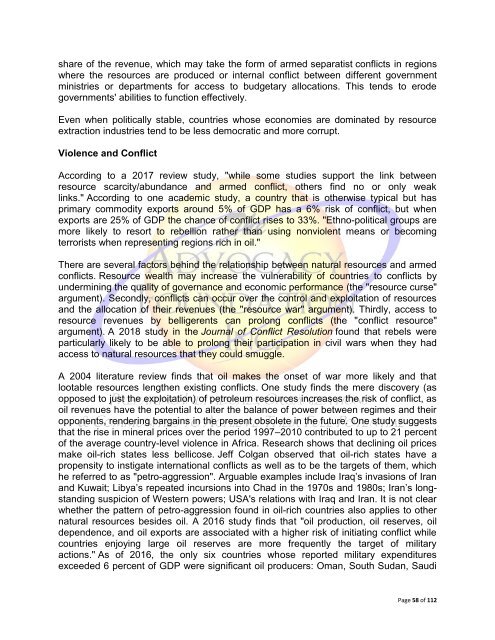De-Industrialization
De-Industrialization
De-Industrialization
Create successful ePaper yourself
Turn your PDF publications into a flip-book with our unique Google optimized e-Paper software.
share of the revenue, which may take the form of armed separatist conflicts in regions<br />
where the resources are produced or internal conflict between different government<br />
ministries or departments for access to budgetary allocations. This tends to erode<br />
governments' abilities to function effectively.<br />
Even when politically stable, countries whose economies are dominated by resource<br />
extraction industries tend to be less democratic and more corrupt.<br />
Violence and Conflict<br />
According to a 2017 review study, "while some studies support the link between<br />
resource scarcity/abundance and armed conflict, others find no or only weak<br />
links." According to one academic study, a country that is otherwise typical but has<br />
primary commodity exports around 5% of GDP has a 6% risk of conflict, but when<br />
exports are 25% of GDP the chance of conflict rises to 33%. "Ethno-political groups are<br />
more likely to resort to rebellion rather than using nonviolent means or becoming<br />
terrorists when representing regions rich in oil."<br />
There are several factors behind the relationship between natural resources and armed<br />
conflicts. Resource wealth may increase the vulnerability of countries to conflicts by<br />
undermining the quality of governance and economic performance (the "resource curse"<br />
argument). Secondly, conflicts can occur over the control and exploitation of resources<br />
and the allocation of their revenues (the "resource war" argument). Thirdly, access to<br />
resource revenues by belligerents can prolong conflicts (the "conflict resource"<br />
argument). A 2018 study in the Journal of Conflict Resolution found that rebels were<br />
particularly likely to be able to prolong their participation in civil wars when they had<br />
access to natural resources that they could smuggle.<br />
A 2004 literature review finds that oil makes the onset of war more likely and that<br />
lootable resources lengthen existing conflicts. One study finds the mere discovery (as<br />
opposed to just the exploitation) of petroleum resources increases the risk of conflict, as<br />
oil revenues have the potential to alter the balance of power between regimes and their<br />
opponents, rendering bargains in the present obsolete in the future. One study suggests<br />
that the rise in mineral prices over the period 1997–2010 contributed to up to 21 percent<br />
of the average country-level violence in Africa. Research shows that declining oil prices<br />
make oil-rich states less bellicose. Jeff Colgan observed that oil-rich states have a<br />
propensity to instigate international conflicts as well as to be the targets of them, which<br />
he referred to as "petro-aggression". Arguable examples include Iraq’s invasions of Iran<br />
and Kuwait; Libya’s repeated incursions into Chad in the 1970s and 1980s; Iran’s longstanding<br />
suspicion of Western powers; USA's relations with Iraq and Iran. It is not clear<br />
whether the pattern of petro-aggression found in oil-rich countries also applies to other<br />
natural resources besides oil. A 2016 study finds that "oil production, oil reserves, oil<br />
dependence, and oil exports are associated with a higher risk of initiating conflict while<br />
countries enjoying large oil reserves are more frequently the target of military<br />
actions." As of 2016, the only six countries whose reported military expenditures<br />
exceeded 6 percent of GDP were significant oil producers: Oman, South Sudan, Saudi<br />
Page 58 of 112

















